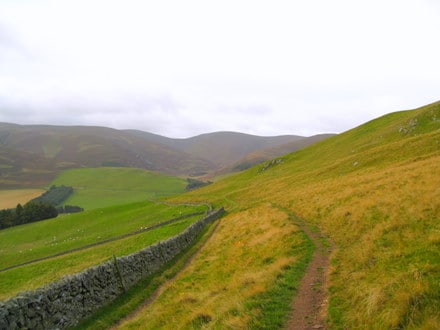
I think I gave the night porter a fright this morning when I came bounding down the hotel stairs before dawn. It was raining and cold outside as I set out, determined to climb Cademuir Hill just outside of Peebles, Scotland. I wolfed down a Cadbury’s Milk Chocolate Bar and drank some water to get my energy up and then wandered about town in the dark for a while trying to find the trail head for the John Buchan Way (JBW), a 13 mile trail linking Peebles to Boughton, named in honor of a famous local author.
My destination, Cademuir Hill, was a 5-6 mile round trip from town and our hotel, The Tontine, where I needed to meet my wife for breakfast by 9 am. The hill is notable because it is a local highpoint at 407 meters, and the site of two old forts, including one with chevaux de frise, sharp projecting stones set firmly in the hillside, designed to halt charging enemies.
I walked across Tweed Bridge following the signs to the JBW into a nice residential area south of Peebles center, where the homeowners name their houses, passing The Anchorage and The Tantah House, before coming to a gate leading to a hilly cow pasture. From there the trail continued uphill through pastureland and heather over several windswept hills, past a large stand of coniferous trees.
Trees grow in wooded clumps in these hills, hemmed in by walled pasture. Bowed by the stiff breeze, they sounded like a rocky stream in spate, that drowned out all other noise around me. The wind has been a constant companion on all of my dawn walks, blowing stiffly and icily against my bare skin and light fleece hat. This morning, I was suited up in a hard shell and rain pants with several layers of Capilene underneath for warmth.
I climbed my hill and had a commanding view of the surrounding countryside and many sheep. The hills here are very steep. I wonder how they came to be that way. They’re also very exposed to the wind. Kneeling on one leg didn’t help reduce the chill, so I came down a bit and got out of the wind following the mowed path back to Peebles.

On the way back I came by some blooming heather and some burnt heather. I assume that the farmers burn the heather to create tender new shoots for their sheep to eat.
The sky was dark when I climbed Cademuir in the morning, but the clouds were gradually breaking up as I walked home. There’s something about Scottish sunshine that is always inspiring for me. There’s a Scottish painter, named Turner, whose work I am very fond of. His paintings all exude a golden glow as if the light source is in the middle of the canvas and not shining on its subjects from above.

That’s the experience that I have when I see the Scottish countryside. The sunlight here appears to exude from the earth itself and not from the sky.
 SectionHiker.com Backpacking Gear Reviews and FAQs
SectionHiker.com Backpacking Gear Reviews and FAQs
Beautiful pictures. I hope you get a chance to hike in the northern parts of Scotland, the Northwestern Highlands are beautiful and lonely, especially in the colder seasons. I made two trips, one "North Sea Coast to Atlantic Coast"-Trip in early March and another one from Ullapool to the Northern Coast via Assynt in late September/early October.
Assynt and Sandwood Bay were especially beautiful :)
Some pictures:
https://picasaweb.google.com/mike.laumann/Schottla…
https://picasaweb.google.com/mike.laumann/Schottla…
Michael – Wonderful photos! I have actually been hiking in the Ullapool area several times. We usually stay at the Ceilidh Place – they have the best live music, food, and books north of Inverness.
Enjoy the holiday. It looked a fine morning walk you had.
Martin – we've had a great vacation and I sent in my Challenge application yesterday with a postal order made out to 30 pounds. Hopefully it will get delivered with the postal slowdowns, in progress.
Cademuir is designated by UK "hill baggers" as a "marilyn" (you may have heard of Munros!) – This is a hill with 150metres of ascent on all sides – so there's usually a good view.
The burning of heather is done on rotation to renew heather shoots which are food for grouse – which are shot for sport. Its very big business on British moors. The burning produces a distinctive patchwork pattern on heathery hills. Burning takes place in March/April and sometimes in autumn.
I'd heard of Marilyns. It was a fine view, but a too brief hike.
Grouse eat heather…can't say I knew that. I suppose it's a good thing to avoid the burnt spots if there are stalkers out and about.